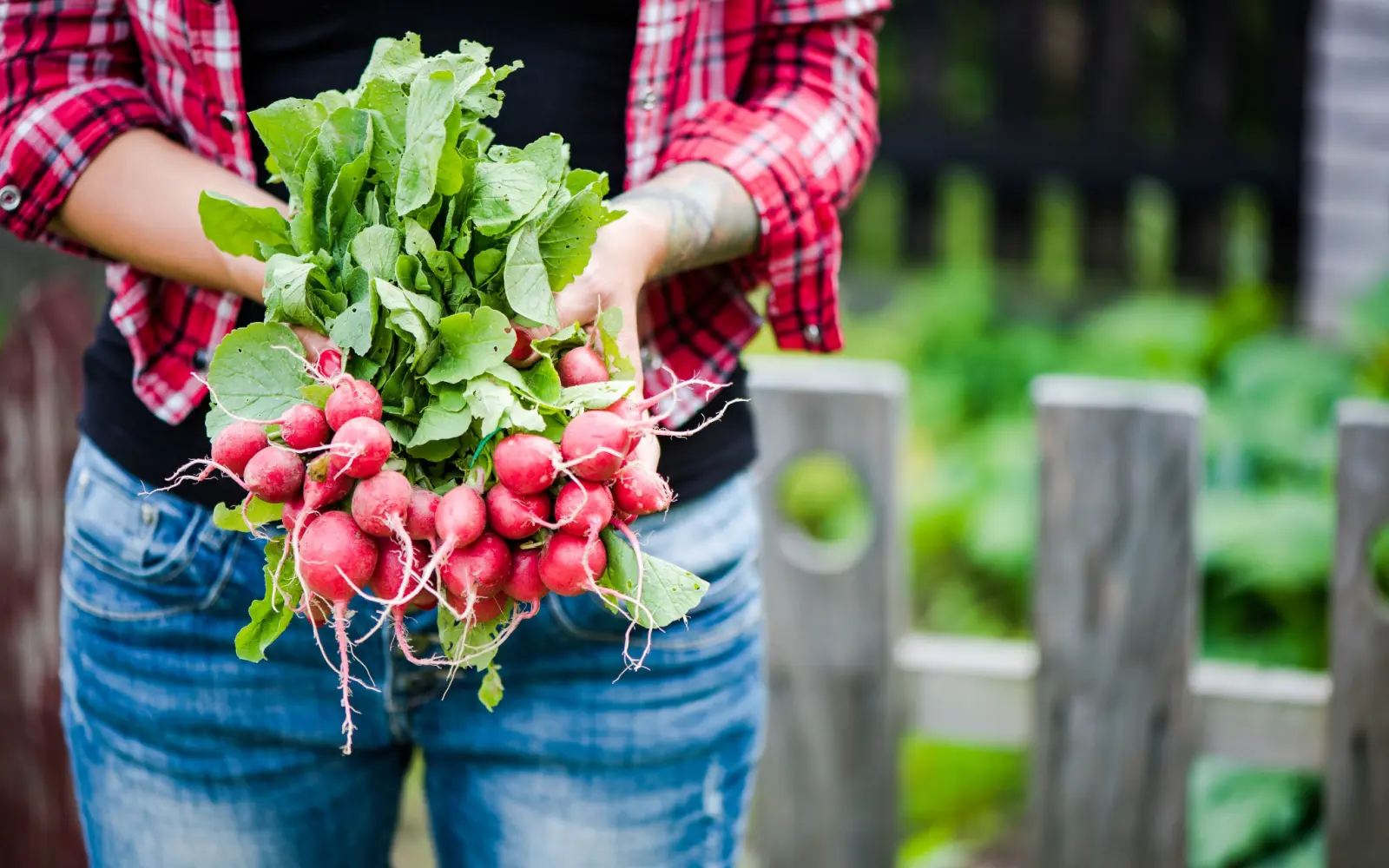There’s a wide variety of radish shapes, sizes, and colors. Keep reading to learn what popular types of radishes exist!
7 Types of Radishes: A Summary
There are many different types of radishes that you can find. Let’s look at some of the most common types of radishes:
- Red radish
- White radish
- Horseradish
- Black radish
- Watermelon radish
- Chinese Rose radish
- Daikon radish
The 7 Different Types of Radishes You Can Eat
Radishes vary in taste, from mild and neutral to spicy and flavorful. Radishes are a part of the Brassicaceae family, which includes mustard greens, kale, and broccoli.
1. Red Radish
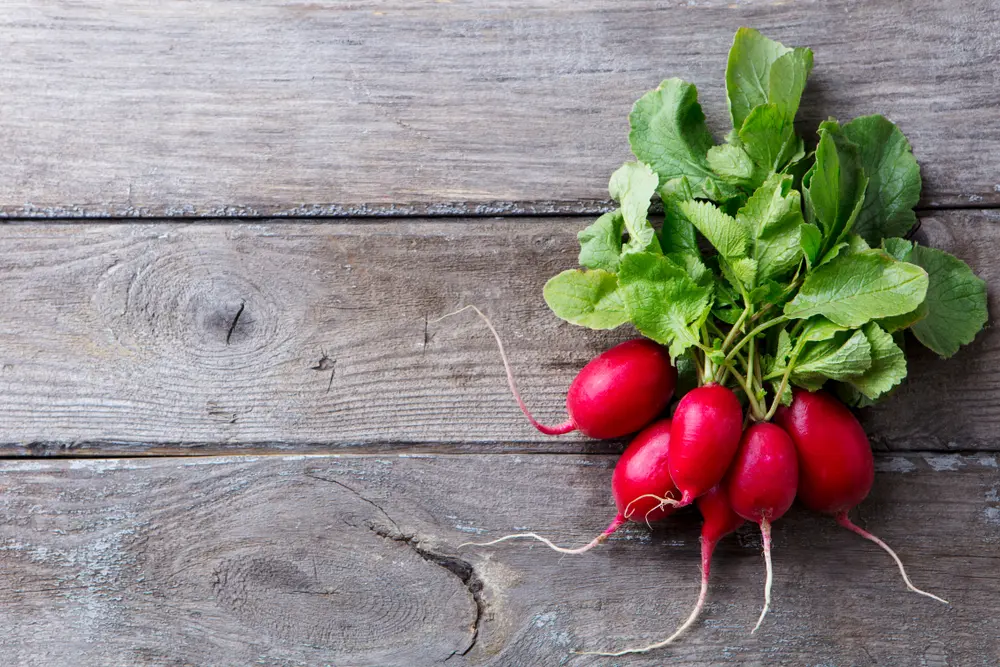
Anna_Postynnikova/Shutterstock
As well as having a crisp texture, red radishes also have a slightly spicy taste to them. The red radish, or Raphanus sativus, is a root vegetable cultivated since ancient times.
Among the various types of radishes, red radish is the most common type. It’s usually about 2–3 inches long and has a slightly spicy flavor.
Radishes are native to Europe, Asia, and parts of northern Africa. European settlers brought the radish to the Americas in the 16th century. Since then, radishes have been a staple in American cuisine.
Many traditional dishes feature red radishes, including the following:
- French salad Nicoise
- German potato salad
- Italian-pickled vegetables
You can eat red radishes raw, cooked, or pickled. They have a crisp, crunchy texture and a sharp, peppery flavor. This sharp flavor shines when the radishes are roasted.
2. White Radish
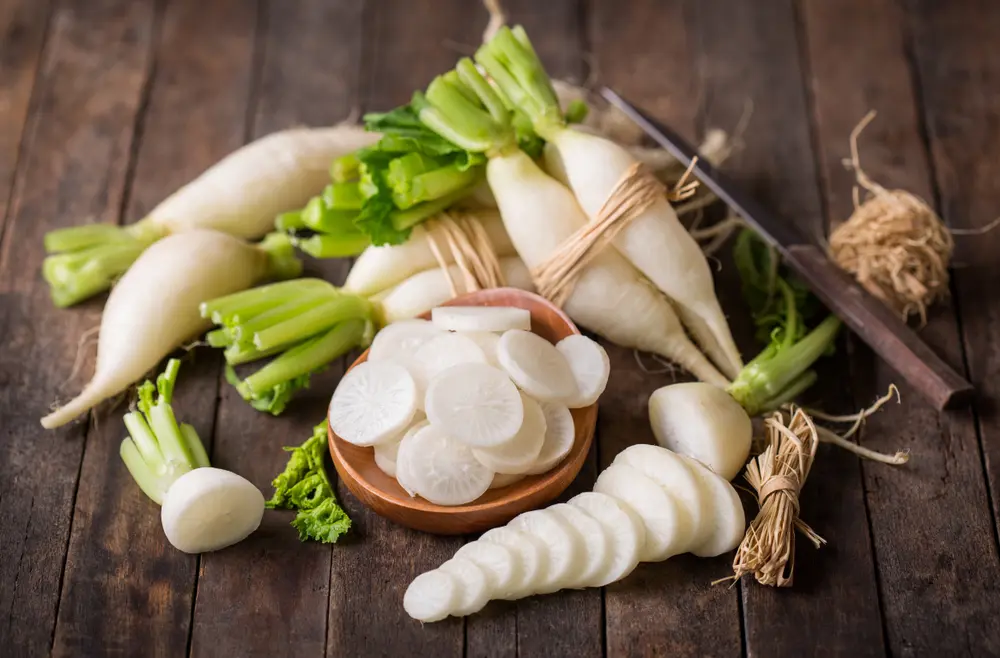
Philipphoto/Shutterstock
White radishes are milder in flavor than red radishes. They have a crisp texture and are perfect in salads or pickled dishes.
Many traditional dishes feature white radishes, which vary in taste depending on how you prepare them.
White radish can have a milder flavor when eaten raw or a more intense flavor when cooked. The root vegetable is excellent in:
- Stir-fries
- Soups
- Stews
It has a crunchy texture; you can use it as a garnish or topping for salads and other dishes. White radish is also a popular ingredient in kimchi, a traditional Korean dish made of fermented vegetables.
You can make kimchi with various types of radishes, but white radish is the most commonly used variety. The fermentation process gives kimchi its characteristic sour and spicy flavors.
In China, white radish soup is a popular dish during the winter. Other ingredients, such as pork, ginger, and scallions, are often added to the soup to enhance the flavor.
3. Horseradish
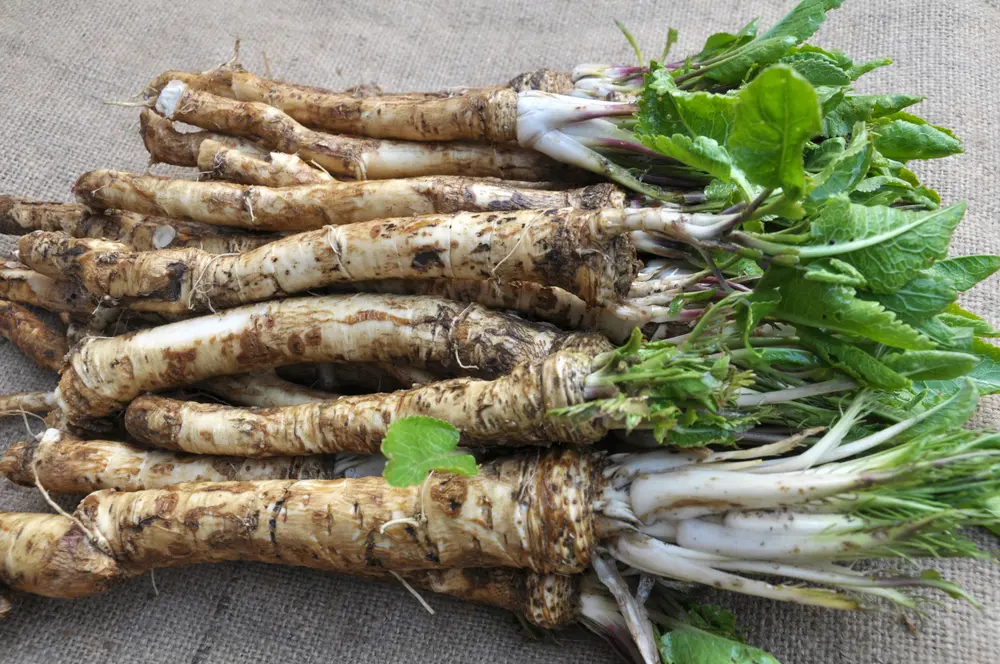
Orest Lyzhechka/Shutterstock
Horseradish is a root vegetable that was first cultivated in Europe. Europeans have been using it as a food and medicinal plant for centuries.
The pungent, spicy horseradish flavor makes it a popular ingredient in many dishes, such as sauces, salads, and soups.
Horseradish is also a natural remedy for various ailments, such as colds, congestion, and indigestion. Horseradish probably originated in the Mediterranean region. The first mention of horseradish in print is in a 15th-century German cookbook.
Horseradish has a strong, pungent flavor that you might call spicy. The heat of horseradish comes from a compound called sinigrin, which is also responsible for the root’s distinct aroma.
When you grate or cut horseradish, sinigrin releases and reacts with the air to create a spicy flavor. Horseradish is excellent as a condiment or seasoning, added to dishes such as cocktails, sauces, and soups.
4. Black Radish
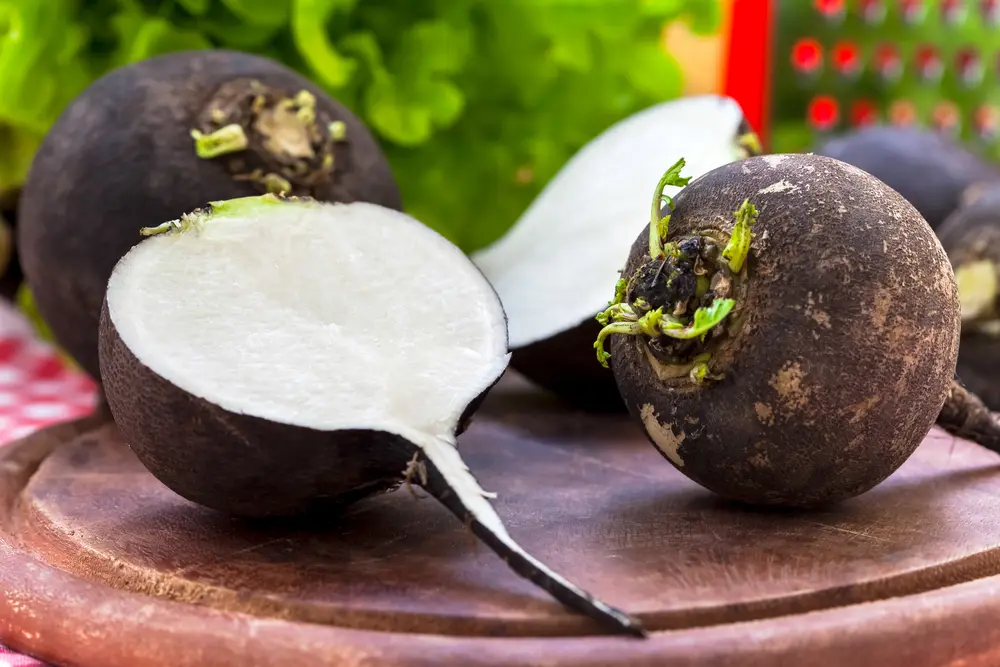
nada54/Shutterstock
Black radishes have a robust and earthy flavor. They are often used in soups and stews; many traditional dishes worldwide feature black radishes as an ingredient.
Black radishes have a sharp, spicy flavor similar to horseradish or mustard. When eaten raw, they can be pretty spicy.
However, cooked black radishes are milder in flavor and can be a delicious and healthy addition to many recipes.
5. Watermelon Radish
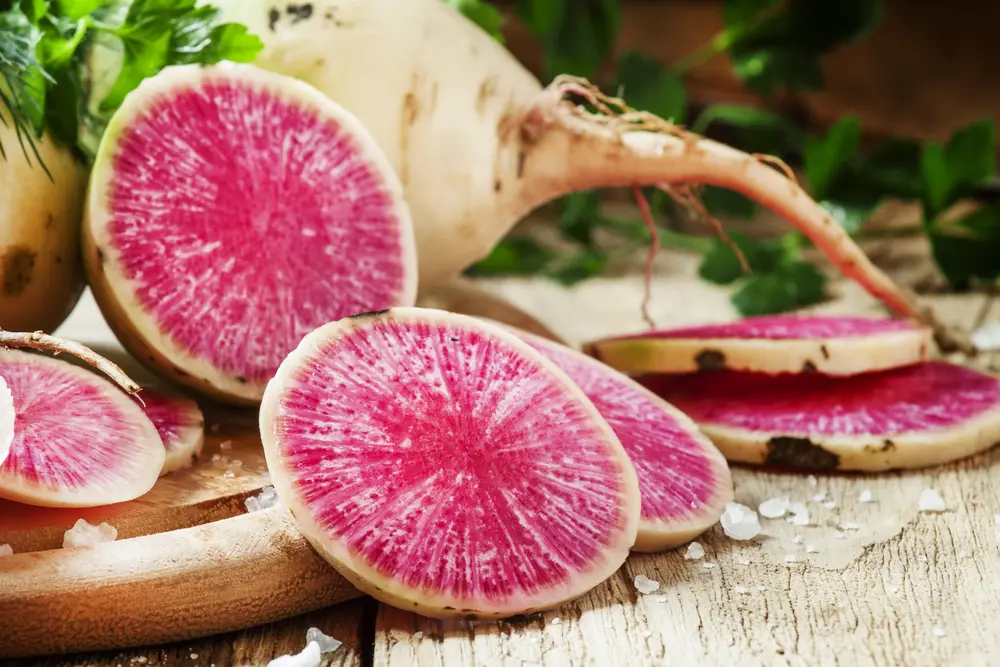
5ph/Shutterstock
Watermelon radishes are a type of winter radish grown in many parts of the world. They get their name from their appearance, which is similar to that of a watermelon.
Watermelon radishes have a crisp texture and a mild, sweet flavor. You can eat them raw or cooked, which are great in salads or garnishes.
Watermelon radishes are a good source of vitamins A and C and contain potassium and fiber. Due to their colorful appearance, people love dressing up salads with this vegetable.
6. Chinese Rose Radish
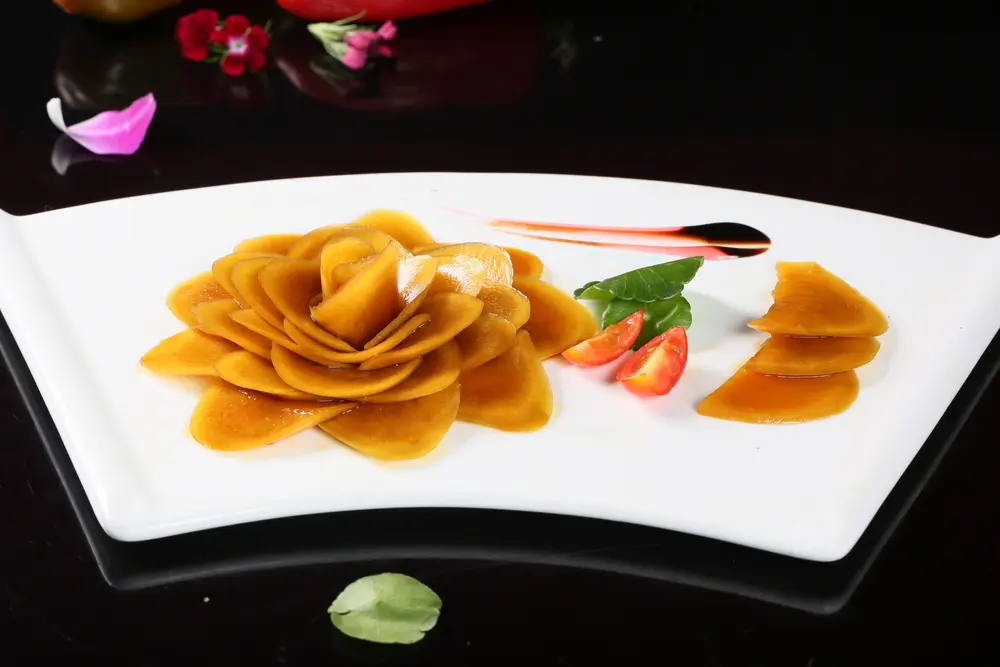
rr923237269/Shutterstock
The Chinese Rose Radish is a unique radish with an elongated shape. This vegetable originates from China, Japan, and western parts of Asia; however, it’s also popular in Europe, where Jesuit missionaries introduced it in the 1800s.
Due to its strong flavor that brings variety to many dishes, it’s a popular choice.
This particular radish can withstand cold temperatures well, which makes it perfect for those living in areas with severe winter weather.
7. Daikon Radish
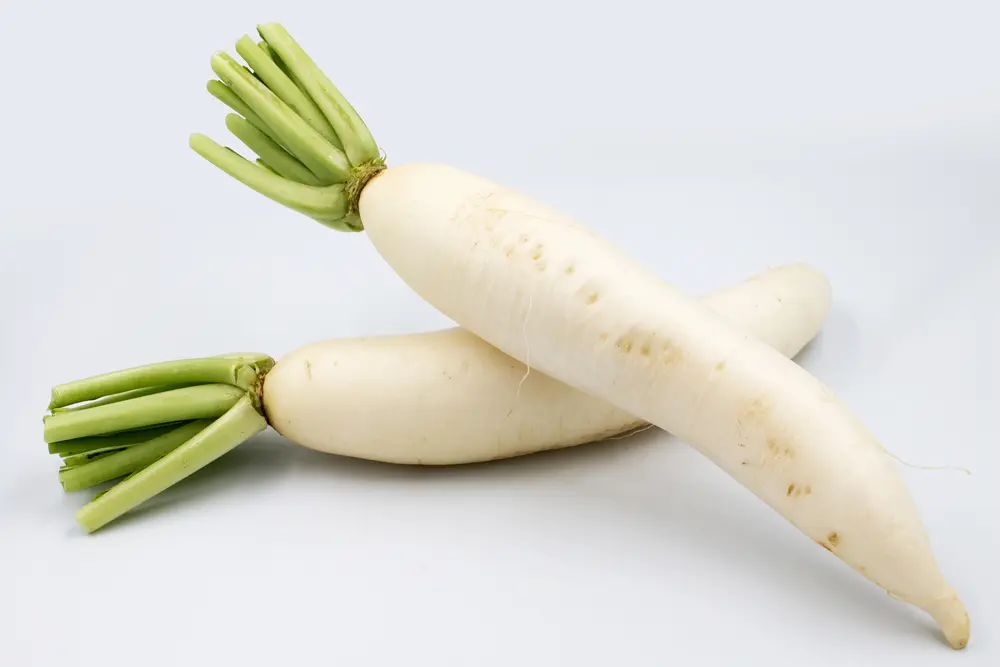
I Am Em/Shutterstock
Daikon radishes are large, white radishes. Their flavor is mild, and their texture is crunchy, making them the perfect snack. They are often used in Asian cuisine and pickled dishes.
The daikon radish is the heftiest type of radish and can grow up to three feet in length and weigh up to fifteen pounds. The name “daikon” comes from the Japanese words for “large” and “root.”
Daikon radishes likely originated in Southeast Asia and spread to China, Japan, and India over two thousand years ago. Many traditional dishes from around the world feature daikon radishes. In China, they are often used in stir-fries or pickled.
In Japan, daikon radishes feature a type of soup called oden, which includes hot fish cakes. Indians use daikon radishes in many curry dishes.
Daikon radishes have a milder flavor than other types of radishes. They are often eaten raw, in salads, or as a healthy snack. When cooked, daikon radishes become sweet and tender.
Things to Consider About Radishes
You’ll want to consider a few things when choosing which radishes to include in your dish.
Heat Levels
How much heat do you want? Daikon radishes have a milder taste, while black radishes are spicy.
Radishes get their spiciness from the presence of a compound called isothiocyanate. This substance is responsible for mustard and horseradish’s sharp, spicy flavor.
When you eat radishes, the isothiocyanate is released and reacts with water to produce a spicy sensation. The amount of isothiocyanate in radishes varies depending on the variety, with some types being much spicier than others.
The heat of radish can also come from how you prepare it. For example, slicing or crushing a radish will release more of the compound than simply eating it whole.
Texture and Crunch
How crunchy do you want your radish to be? Daikon radishes are crunchier, while watermelon radishes have a softer texture.
Whether in a salad or soup, radishes add a variety of textures. Choose the right radish for your dish so that it complements the other ingredients.
Taste
One of the most crucial factors to consider when buying radishes is taste. If you’re looking for a sweeter radish, choose a watermelon radish, while daikon radishes work well in pickled dishes.
But the best way to determine which type of radish is best for you is to try them all! Radishes come in many different colors, shapes, and sizes, so there is sure to be one that you’ll love. Give them all a try, and find your favorite!
How to Grow Radishes
It’s simple to grow radishes. You need to ensure you have the right conditions for them. Radishes need full sun and well-drained soil.
They also prefer cooler temperatures, so they are a good choice for spring or fall planting.
If you live in an area with hot summers, you can still grow radishes, but they may not be as crisp and flavorful as those grown in cooler weather. You can harvest your radishes after four weeks. To harvest, pull up the entire plant.
If you’re going to grow radishes, you want to consider the size. Daikon radishes can grow up to 3 feet, while red radishes are typically about 2 inches long. Watermelon radishes are somewhere in between, at around 6-8 inches.
Frequently Asked Questions
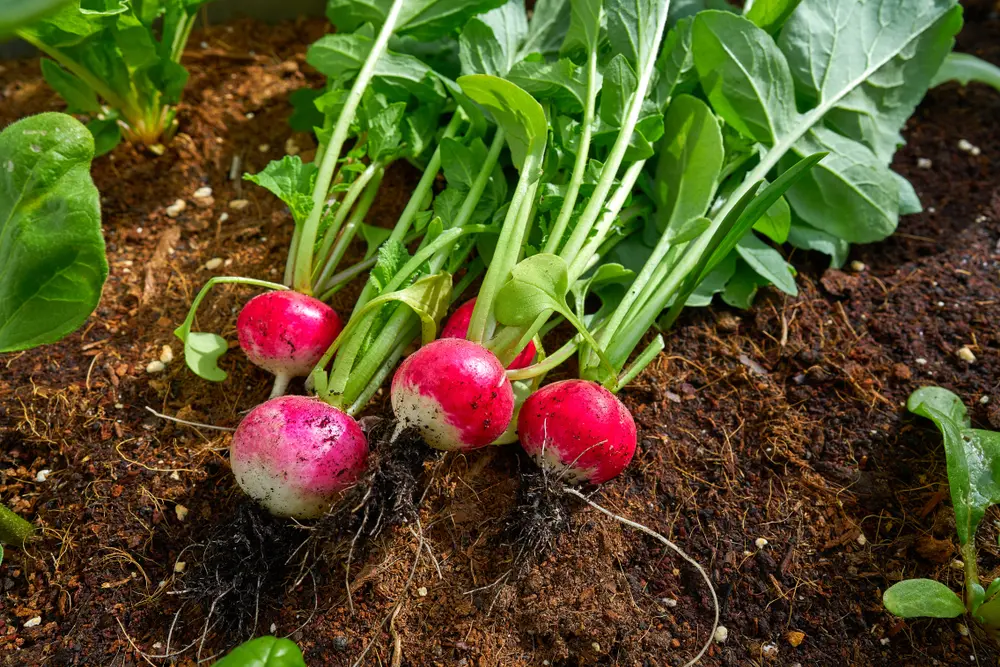
Lunamarina/Shutterstock
Radishes are a popular food for many reasons, and there are so many different types of radishes.
If you have more questions about these unique vegetables, check out these common questions.
Are radishes healthy?
Radishes are a good source of vitamin C, potassium, and fiber. Radishes also contain antioxidant properties that may help reduce the risk of certain diseases. They are also low in calories and fat, making them a nourishing addition to any diet.
If you are looking for a crunchy, flavorful vegetable to add to your next meal, consider trying radishes. You may feel surprised at how versatile and delicious they are!
How many types of radishes are there?
There are many different types of radishes, including red, yellow, black, and white. In terms of flavor, texture, and appearance, each type of radish has its own unique characteristics.
Radishes also have different shapes, such as long radish or round radish. The taste of radish ranges from sweet to spicy, depending on the type. There are summer and winter radishes.
The red, spherical radish that grows in early spring is the most common type of radish. Spring or summer radishes are usually small, crisp, and have a mild flavor. Winter radishes are larger, tougher, and have a sharper flavor.
How many species of radishes are there?
There are many species of radishes, but red and black are the two most common radishes. The red radish is the most popular and is generally used in salads and as a garnish.
There are also several other less common radish varieties, such as the white radish and the daikon radish. You can also find local heirloom varieties with different colors and characteristics.
What are pink radishes called?
Pink radishes are “Watermelon Radishes.” Pink radishes aren’t a separate type of radish, but rather a variety. This variety is typically slightly larger than a regular red radish and has a bright pink or fuchsia color inside.
The exterior of the Watermelon Radish is usually white or pale green, with dark green streaks.
When you slice them open, they have a beautiful fruity appearance that brightens up salads and other dishes. The flesh is crisp and crunchy, with a slightly sweet flavor. Watermelon Radishes are typically in season from late fall to early spring.
What do pickled radishes taste like?
Pickled radishes tend to have a sharp, tangy flavor that is slightly sweetened by the pickling process. You can easily pickle radishes at home to enjoy later. They are often used as a garnish or added to salads for a bit of flavor and crunch.
So, What Are the Different Types of Radishes?
Radishes are an interesting and diverse group of vegetables that offer many benefits. They come in many shapes, sizes, and colors, and they have a wide range of flavors.
So whether you want to enjoy radish in a salad or pickle some vegetables, there’s a radish out there for every dish.

